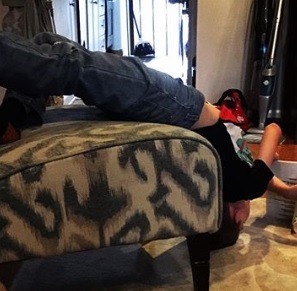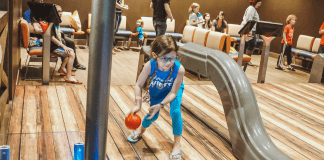Is your kiddo bouncing off walls? Will they literally stop in the middle of doing anything and start doing jumping jacks? Have you thought, “Sports. This kid needs sports,” only to watch him/her start the spin drill and continue to spin because they get caught up in the motion. Do you feel like you say “sit still” or “focus” more than any other word? Have you always been anti-leash for kids only to look at your own child and honestly consider one? Do you feel lost because all you feel like you are doing is getting on your child to “stop” and “follow the rules” and you’ve tried everything under the sun (timeout, remove from xyz, take away blah blah blah) and nothing changes?
Yes? Okay – let’s chat.

Our son did not speak at three, yet could communicate just fine. He quickly would grasp ideas but have no interest in doing them after. While he liked to make music in his room, music class was torture. He was literally jumping off the bleachers and hiding behind the curtains. During circle time, he was that kid rolling around on the ground or pacing the back of the room. He showed no interest in phonics and every report was the same, “fine with academics but learning classroom behavior.” At five, it was torture to do a single page of simple math problems but I could ask him novice division questions (video here).
He was (is) the definition of fitting a square peg into a circle hole. Many times I was frustrated with parenting. Why was this not working? He’s such a sweetheart of a child, yet this enormous amount of energy was hindering his ability to move forward. There were clear issues showing signs of sensory distractions but there was more to the equation… and I couldn’t figure it out.
So a few tests later and many months/years of unsuccessful attempts at parenting this child into listening, we had something to work with… something I had never even heard of. My child was highly a visual-spatial learner.
Say what?
Turns out 1/3 of our kids (and really, all people) are visual-spatial learners. Many are a mix of visual-spatial and auditory-sequential and some are mainly auditory-sequential.
Again, say what? I had no idea what these terms meant either.
Here is what I knew to be true – when my kiddo was bouncing off the walls, his brain was fired up ready to learn, create, explore and there was no outlet. Those dreadful waits in any line (checkout, docs, etc) would leave me almost sweating trying to contain him until I started asking “how many squares you do see you? This is an ‘A.’ How many can you find?” While I knew these tricks worked, I had no idea what this new term, Visual-Spatial Intelligence, meant?
It helped me to understand visual spatial by understanding the opposite: auditory-sequential. School is taught largely in an auditory-sequential manner (verbally and step by step). The subject is explained and an action is repeated until mastered and then, as a class, you move to the next step. Visual-spatial learners do not learn step by step, they learn big picture and then break it down. When the step-by-step method is being taught, they often are lost from the start because they can’t see where they are going and will allow their minds to drift to something else that will entertain them (for my son, that was pretending to be a puppy during carpet time).
Take learning how to spell a word. First, learn the letter sounds. Then sound it out to read it and then sound it out to spell it. It is sequential (step by step). Great…if you learn that way. Our son HATED spelling and reading until we rented Hooked on Phonics from the library. Within a month, he was reading and at six, is reading this book (Incredible Cross-Sections – highly recommend it!):

Why is it phonics could lead to a meltdown but with Hooked on Phonics, he was fine? He is a visual learner. He needs to literally see the words connect to make it click in his head and then after that, the learning in permanent. There is no need to repeat it. For spelling, flashcards written with the words as a cartoon or on bright paper or maybe in a certain handwriting could be your trick. Recently, I even stumbled upon Snapwords. Take a second and click the link – they are pretty sweet.
Sometimes, early visual-spatial reader will learn the word by how they see it (whole picture and not in parts of the word). My son was telling me about “tekinitics” the other day (telekinesis). Clearly, he didn’t read the word correctly but was explaining in detail precisely what it meant. Even though he didn’t read it correctly, he understood the idea. This is because he doesn’t learn in parts (stretching out the word), he absorbs it as a whole.
Speed reading may be a great tool for engagement. On the opposite end, teach to slow multiple choice tests down because they easily could skip the word “NOT” by speed reading. I used to complete tests backward because, for some reason, it helped me to read each word of a question. Also, it helped to not get stuck on the people who had already finished a page because they comprehend and read in words and did not need to turn each sentence into a running movie in their mind.
Do you find your child seemingly cannot hear you ask a question if he or she is busy drawing, reading or building with Legos? Do you find when you give them three or four things to do in a row, one may get done, but then they also may get distracted on the way and then gets done? Do you often feel like you are asking, “Did you hear me?” Our child needs to completely stop what he is doing to hear us.
Since he doesn’t learn through auditory cues, when we give a long list of auditory instructions, it won’t get done. Pictures work. I have read tricks of people making a stack of cards with pictures of the morning routine and handing them to their child at the start of the day. When he is through all the cards, he is ready for school without the morning nag, yell, rush.
Visual-spatial learners literally turn words into pictures in their mind. They learn and think in PICTURES. This is key to helping them with school work. Take history. You are learning about the War of 1812. The teacher rattles off names and who was on each side and what it is over. Maybe you even have five minutes to read the section on it. The auditory-sequential learner is able to recall that information and chat about it. The visual-spatial learner is still stuck on trying to form a picture of what is going on and by the time they have one part formed in their mind, the lesson is over.
Perhaps instead of learning first about the war and then moving to a test, pre-watch a history channel lesson on the War of 1812. Let the pictures come together in the mind so when they learn about the specifics, say James Madison, there is an image of who he is in your child’s mind. Potentially even tell them the end result of the War. The kicker is he MUST see the BIG PICTURE to care about the specifics. They MUST have time to visualize the information and turn the words into a picture to learn. Without this, retention cannot happen.
But here is a pretty awesome note (and also frustrating for many). Once the information is learned, repetition is not necessary. This is fantastic when you think “learning is permanent” and pure torture when you look at a group of worksheets with the same information over and over. Sure, there is value to teaching them ‘sometimes you have to do the work and sit through things that are boring‘ and there is also understanding when a kid is young, that maturity is not necessarily there. Honestly, we told our daughter once “finish the sheets as best as you can (don’t rush it, do it well) and then draw in a notebook while you wait.” She often had her papers front and back with drawings.
Does your kiddo have poor penmanship and get q’s, p’s, d’s and b’s all mixed up? My friend taught me the trick of teaching my child that the word “bed” makes an actual bed (headboard/mattress/baseboard) and can help remember which direction the letters go. The task of actually writing and organizing thought is found in the left hemisphere, so if your child is highly visual-spatial (right hemisphere), this is a bit of a challenge. For upper grades, perhaps a keyboard would be an option for taking notes in class and when composing papers/projects, allow for a brainstorming session and then take those notes and organize the thoughts instead of making the first step organization.

Another kicker with writing and learning…how do you write (left hemisphere) and turn the lesson into pictures (right hemisphere) simultaneously? In school, I often had to take notes without trying to learn so I could write the lecture almost verbatim, go home and slow it down to picture what the words meant. If I tried to listen to the lecture, I couldn’t keep up in creating the pictures in my head and would miss half the lecture. If I wrote and tried to listen, my notes made no sense because I ended up writing random words that were being said in the midst of the picture. Eventually, I just wrote everything down and taught myself later, praying I wouldn’t get called on since I couldn’t keep up during class. Today, your child may be allowed to take in a tape recorder (upper grades). This may help him/her stay engaged but be able to slow the pace down at home.
Many times with visual-spatial learners, adding movement will help the information stick. You mean to tell me my energetic child can MOVE to LEARN! Yes, yes, yes! This we can do! How could I have missed this trick when I literally would pace my room back and forth while studying? It helped retain the information. Don’t just count items using a paper and a drawing, have them move around the room to count. We often find our kids reading upside down, building, doodling, etc and they can tell you exactly what they were learning about.

Use legos, straws, props to help with math facts and not just worksheets. Games help with math facts (pretty much any of the games with a dice) but you can also hit up the Art and Education stores to find specific games for education. “Schoolhouse Rock” videos on YouTube can help making numbers easier to remember, also. Art can be combined with math to make it more of a visual task. Yes, these all take time but if a person HAS to turn it into a picture to learn it, and simply cannot by listening and repetition, it is worth the time.
By no means am I saying ask your teachers to reinvent the wheel. Much of this may need to be done at home. I have reached out ahead of time to teachers to inquire on the syllabus. At home, I try to cover the big picture items so when it is reviewed at school, they are able to truly absorb information because they can visualize it. I know it is extra work on our ends as parents, and who has time? I will do my best to keep this information coming your way through Cincinnati Moms Blog and my own personal blog.
Below are some sources I have found to help tremendously. If you think something is up, seek help. There are more resources out there (occupational therapists) and many are provided in school.
This is a journey. What everyone says is good for your child, may not be. Do your best and don’t give up. Find groups of people that get it. Some of our closest friends and family have given us suggestions that have left us flabbergasted. They mean well; remember that. Take what works and is worth your time and try it and let the rest go. So long as you are giving it your all to raising respectful, caring, hardworking individuals, if the path is a bit upside, crazy and in swirls, who cares.
And good luck. This high energy world is hard. You will get the both looks and the people who understand and have been there. When you get the latter, thank them and hold onto those friendships. Your kiddo is probably pretty awesome. In the words of Dr. Suess, “Why fit in when you were born to stand out?” We cannot extinguish their light but we can help them to not blind everyone in their path. Sometimes “helping” is understanding why the switch is turned on so high.
Here are some resources to get you started:
Visual Spatial Resources
Some tricks for school
Help with Math Facts (these can be found on Amazon also)
Raising Topsy-Turvy Kids
Upside Down Brillance
Living with Intensity
For kids with Sensory Issues:
Any of these books by Jennifer Veenendall
Superkids Guide (the author has a great page on Facebook)
Out of Sync Child
And ps – I wasn’t kidding about the Spin Drill question:












